
Contact
Biological mapping
Børge Holte
+47 77 60 97 53
Geological mapping
Terje Thorsnes
+47 73 90 42 75
Bathymetry
Hanne
Hodnesdal
+47 51 85 88 23
Information officer
Beate Hoddevik Sunnset
+47 55 23 85 16

Published: 13.06.2008 Updated: 24.10.2019
The Norwegian seabed mapping programme, MAREANO, has just finished its fourth cruise off northern Norway with the research vessel G.O. Sars. The target of this cruise is deeper slope areas off the counties of Troms and Nordland. The investigation covers several very different marine landscapes including submarine canyons, coral reefs, moraines, sand dunes and consolidated clay with rough topography.
By Pål Buhl-Mortensen and Lene Buhl-Mortensen
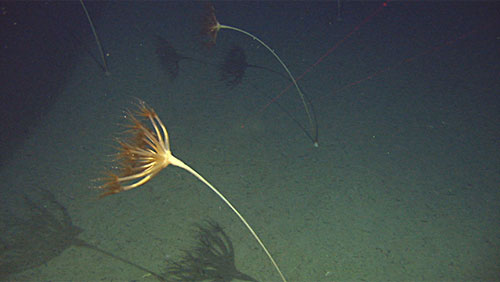
In one of the canyons the seapen Umbellula occured in
relative high densities with just a few meters between the
individual colonies. This seapen has very large polyps.
Many interesting creatures have been filmed or brought up to the surface. Among the highlights are the discovery of three new coral reefs, a strange benthic jellyfish, and mysterious holes in the seabed. The identification of the creatures sampled and video-recorded during the cruise will provide interesting challenges and good opportunities for valuable scientific contributions.
On a submarine nose west off Andøya we found a beautiful giant hydroid. This is probably a species belonging to the genus Corymorpha, with an impressive size of 25 cm. This is large for a single polyp. Another giant cnidarian we encountered was the Umbellula seapen. With a size of 2.5 m this spectacular animal increases the wow-factor in the control room up in the vessel. One nice specimen was brought up in the beam trawl.
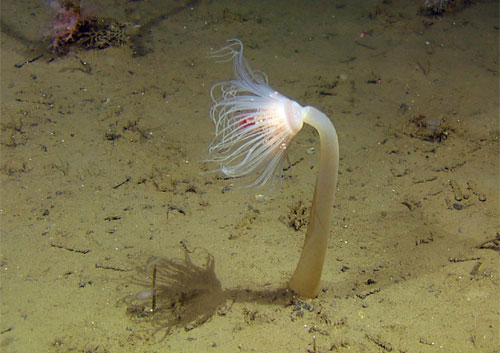
At around 1000m depth on a nose west of Andøya we found this
gigantic Corymorpha hydroid.
Benthic jellyfishes have not been detected during previous MAREANO cruises in shallower water. On this cruise, however we have observed a characteristic species of which we dont yet know the name. Overall, there are lots of surprises when filming the seabed at low altitude and great depths.
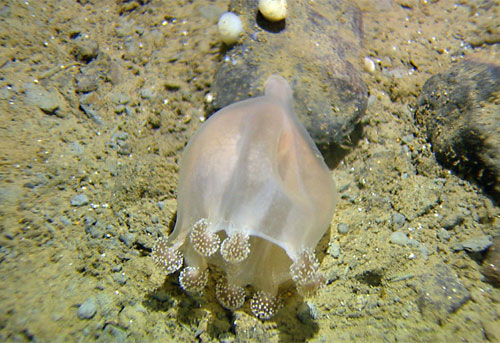
This is in fact a jellyfish sitting on the seafloor! We found it
several places deeper than 1000 m. Anyone seen it before? Please
let us know.
Inside the shelf break, southwest of the Malangsgrunnen bank we discovered three coral reefs previously not known. These are like all the rest of the Norwegian coral reefs built by the colonial stone coral Lophelia pertusa. They were found based on interpretation of the topography on recent maps made by the Norwegian Hydrographic Service.
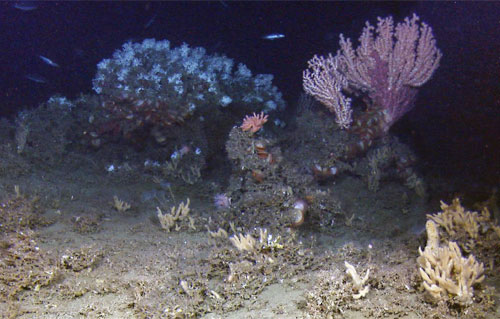
Coral reefs house a great diversity of invertebrate species, and
often there are also lots of fish at these places. Here, we see a
living Lophelia colony in the background and a bubblegum
coral (Paragorgia arborea) to the right.
There are many things that need to function when sampling the deep seabed, and the weather is often a limiting factor. During this cruise we have been lucky and only lost some few days due to strong winds.
On earlier MAREANO-cruises there have been some problems with the video-rig Campod, but his time the child diseases seems to have been eradicated. With the Campod we gain information about the seabed and its fauna from all types of substrates and seascapes, even where grab and beam trawl cannot be used. With this gear we have documented that the variation of habitats and fauna is great on the slope down from the continental shelf break. However, to investigate the seabed further out on the abyssal plain we have to upgrade the Campod so it can resist the pressure at depth below 2000m. The bottom samples we collect with grab, boxcorer, beamtrawl and sled provides important material to make confident species identifications and to provide an assessment of the biodiversity of the area. Most species on the seafloor are small and cannot be identified based on images alone.
The cruise has covered varied seascapes, and as the topographic map indicates the terrain is dramatic with sudden changes in depth. Topography controls the environment in many ways; currents are often lead by it and many places sediments are transported in trenches, troughs and canyons.

A feather star and soft corals (Nephtheidae) at around
1000m depth west off Andøya.
G.O. Sars was not the only vessel targeting the continental slope during this cruise period. In addition to seismic survey vessels in the southern part of our mapping area, the slope form the break down to about 800m is almost completely occupied by fishing vessels going after Greenland halibut. Their fishing season started just few days before we approached the area. The Andøya canyon (the largest submarine canyon in Norway) is an area of particular interest to MAREANO, but it was not possible for us to work there this time. Instead we focused on neighboring smaller canyons further south. Next time, in autumn we go out again to continue the seabed mapping further to the north. Results from the analyses of material sampled during the cruise will be published at www.MAREANO.no as soon as they are produced. So stay tuned for more new discoveries!
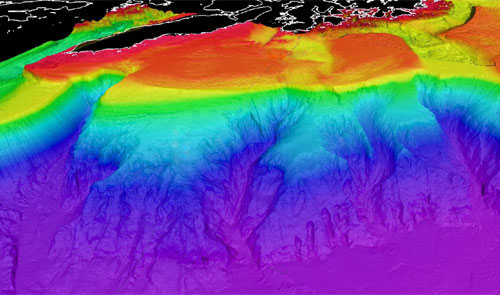
There is a highly varied marine landscape with noses, ridges and
canyons on the slope outside the continental shelf west off the
Island Andøya.